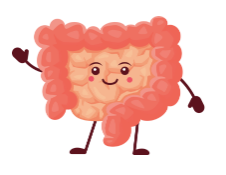A Guide to Gut Health
The term “gut heath” is commonly used when discussing one’s overall health, but what does it actually mean?
Gut health is the overarching term that is used to describe the status of the microbiome within the small intestine, or the “gut”. This gut microbiome contains various types of both harmful and healthful bacteria, fungi, and other tiny microorganisms that play a large role in one’s overall health. This balanced mix of microorganisms work together to digest nutrients, produce vitamins, decrease inflammation, and fight off infections. However, if there is an imbalance between the amount of one’s healthy and harmful microorganisms, it can lead to the development of Inflammatory bowel Disease (IBD), autoimmune disorders, cardiovascular disease, insulin resistance, and obesity.
The good news is – we can control the types of microorganisms that grow within our gut microbiomes to ensure optimal health by adjusting the foods we eat.
There are two major categories of food that are proven to improve and maintain the growth of healthy microorganisms within the gut microbiome.
1. Prebiotics: foods that cannot be digested or absorbed by the body but are fermented within the gut microbiome. This promotes growth and activity of the microorganisms to strengthen the health of the gut microbiome. They can be found in foods with large amounts of plant fibers such oats, beans, bananas, and asparagus.
2. Probiotics: foods that contain live microorganisms. These microorganisms will travel the small intestine and promote balance of healthy and harmful bacteria within the microbiome. They can be found in fermented foods such as yogurt, kefir, tempeh, sauerkraut, and kimchi.
Additionally, foods that contain saturated fats, added sugars, and food additives can hinder the gut microbiome and impair gut health, so it’s important to have a limited intake of these foods.
How to incorporate more prebiotics and probiotics into your diet:
Prebiotics: Include plant foods into your meals
- Choose whole grain cereals, breads, pastas, and crackers.
- Add bananas, almonds, or flax seed into smoothies.
- Add garlic to salad dressings, dips, or to flavor olive oil.
- Add onion to salads, sandwiches, sauces, or to flavor olive oil.
Probiotics: Ferment your favorite vegetables
- Dissolve 2 Tbsp salt into 1 liter of room temperature water.
- Place your vegetables in a large mason jar. Add your salt water, leaving an 1 inch space at the top of the jar.
- Tightly seal the jar and store at room temperature for 2-3 days.
- Confirm fermentation is complete by checking for:
- Bubbles on the surface of the water
- Vinegar smell
- Tangy taste
- After fermentation is complete, enjoy or refrigerate for up to 1 month.
Zhang P. (2022). Influence of Foods and Nutrition on the Gut Microbiome and Implications for Intestinal Health. International journal of molecular sciences, 23(17), 9588. https://doi.org/10.3390/ijms23179588
https://shahzadidevje.com/diy-lacto-fermented-mixed-vegetables/
https://www.chop.edu/health-resources/food-medicine-prebiotic-foods


Comments
Post a Comment